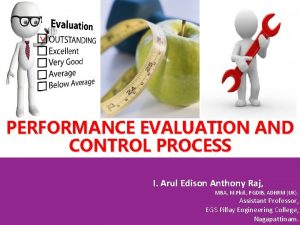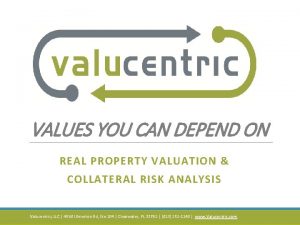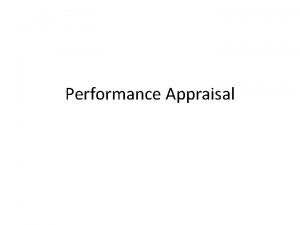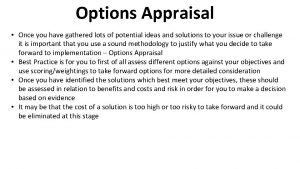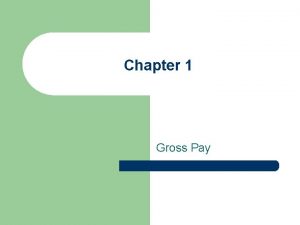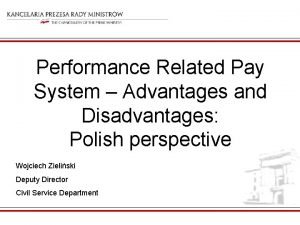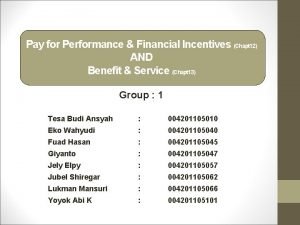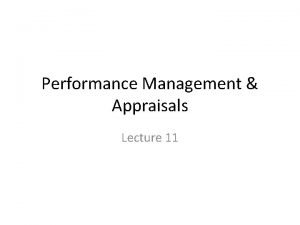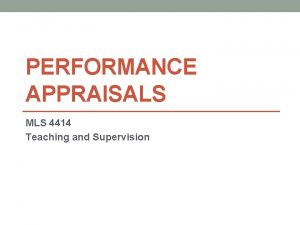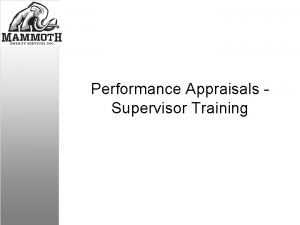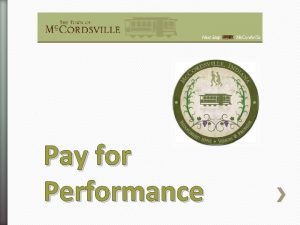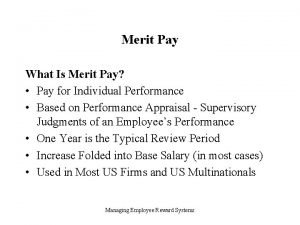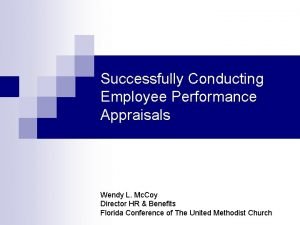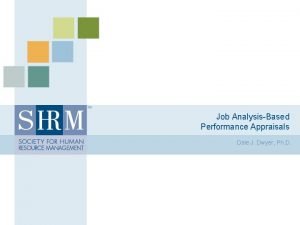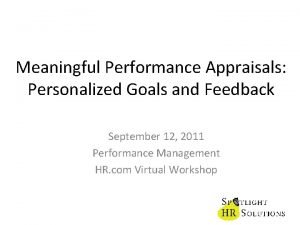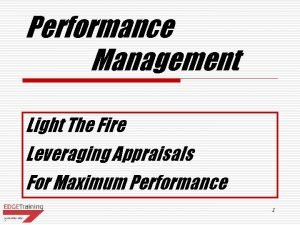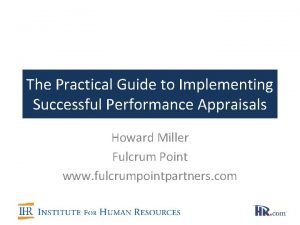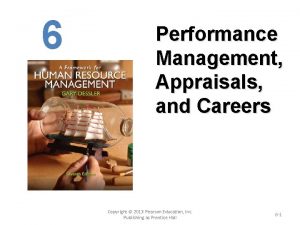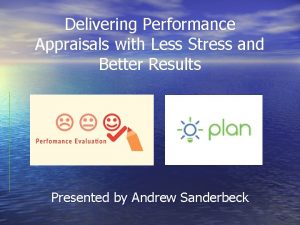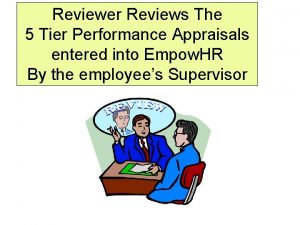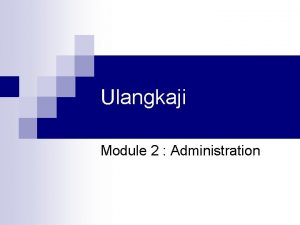SESSION 5 Pay for Performance Appraisals Pay for

















































- Slides: 49

SESSION 5 - Pay for Performance Appraisals Pay for Performance p. 1

Employees Performance SESSION 5 - Pay for Performance Appraisals Ø Three general factors driving employees performance : • Skills & ability to perform task • Knowledge of facts, rules, principles and procedures • Motivation to perform p. 2

SESSION 5 - Pay for Performance Appraisals Principal determinants of job performance Knowledge & Skills Effort (Motivation) Environment Work Organization Behavior Role Personality Job Performance Available resources -Financial -Technical -Material -Human -Temporal p. 3

Motivation Theories SESSION 5 - Pay for Performance Appraisals Ø Based on needs • Maslow’s need hierarchy • Herzberg’s two-factor theory Ø Based on employer/employee’s relationship • • • Expectancy Equity Reinforcement Goal setting Agency p. 4

Motivation Theories Ø Maslow’s need hierarchy SESSION 5 - Pay for Performance Appraisals • Performance-based pay – Must be set high enough to meet basic living needs – At-risk program will not be motivating is it restricts employees’ ability to meet basic needs – Incentive pay is motivating if attached to achievement, recognition, or approval p. 5

Motivation Theories Ø Herzberg’s two-factor theory SESSION 5 - Pay for Performance Appraisals • Performance based pay – Pay level is important - must meet minimum requirements to be considered as a motivator – Performance is obtained through reward : – Security plans will induce minimum performance – Success sharing plans will be motivating – At-risk plans will be demotivating – Other conditions in the working relationship influence performance-based pay p. 6

Motivation Theories Ø Expectancy SESSION 5 - Pay for Performance Appraisals • Performance-based pay – Larger incentive payments are better than smaller ones – Employees must believe they can influence performance targets – People choose the behavior that leads to the greatest reward – Identification of training and resource needs required to meet target levels are essential p. 7

Motivation Theories Ø Equity SESSION 5 - Pay for Performance Appraisals • Performance-based pay – Performance measures must be clearly defined – Employees must be able to affect them through work behaviors – Fairness and consistency employees across the organization is important – Relative pay amongst employees matters p. 8

Motivation Theories Ø Reinforcement SESSION 5 - Pay for Performance Appraisals • Performance-based pay – Timing on payouts is very important – Rewards must be tightly coupled to desired performance objectives p. 9

Motivation Theories Ø Goal setting SESSION 5 - Pay for Performance Appraisals • Performance-based pay – Employees must believe they can influence performance targets – Performance targets should be challenging and specific – Feedback about performance is important – The amount of the incentive reward should match the goal difficulty p. 10

Motivation Theories Ø Agency SESSION 5 - Pay for Performance Appraisals • Performance-based pay – Is the optimal compensation choice for more complex jobs where monitoring employees’ work is difficult – Performance target should be tied to organizational goals – Employees dislike risky pay and will require a higher total cash pay opportunity in exchange for accepting performance-based pay p. 11

SESSION 5 - Pay for Performance Appraisals Components of a Total Reward System Ø Ø Ø Ø Compensation Wages, commissions, & short/long-term incentives Benefits Vacations, health insurance Social interaction Friendly workspace Security Stable, consistent position & rewards Status/recognition Respect, prominence due to work Work variety Opportunities to experience different things Workload Right amount of work (not too much nor too little) Work importance Is work valued by society Authority/control/autonomy Ability to influence others; control own destiny Advancement Chance to get ahead Feedback Receive information helping to improve performance Work conditions Hazard free Development opportunities Formal/informal training to learn new KSAs p. 12

Wage Components SESSION 5 - Pay for Performance Appraisals Ø Compensation components from least risky to most risky for employees : • Base pay • Salary Increase Plans – – Across the board Cost-of-living increase Merit pay Lump-sum bonus • Individual incentive • Sharing Plans – – Success-sharing plans Gain sharing Profit sharing Risk sharing p. 13

Wage Components SESSION 5 - Pay for Performance Appraisals Ø Base Pay • The guaranteed portion of an employee’s wage package • This is the secure portion of wages • Viewed as a fixed cost to the employer – Can be lowered by employers in some countries (i. e. US UK, Switzerland) based on company performance. – Not possible in most EU countries without harsh union negotiations – Could be lowered on a voluntary basis (e. g. HP) p. 14

Wage Components SESSION 5 - Pay for Performance Appraisals Ø Salary Increase Plans • Across the board • – Wage increase granted to all employees, regardless of performances – Low risk even though at discretion of employer Cost-of-living (COL) – Same as above but based on local COL indexes • Merit pay – Salary increase based on individual performance – Size of merit pool at discretion of employer • Lump-sum bonus – Same as merit pay increase but paid as a one-time payment – Not added to the base salary (i. e base salary level stays untouched) p. 15

Wage Components SESSION 5 - Pay for Performance Appraisals Ø Sign-in bonus • Lump-sum or installment bonuses designed to attract new high performers to join a company or take a new challenging position within the organization Ø Stay-on bonus • Lump-sum or installment bonuses designed specifically to retain key employees during and after a major restructuration (e. g. Chapter 11 or after a merger & acquisition) p. 16

Wage Components Ø Individual Incentives • Are either : SESSION 5 - Pay for Performance Appraisals – An add-on to a fixed base pay - lower risk => Base Salary plus Bonus = Total Cash (TC) – A variable portion of the overall pay - higher risk but higher earning potential => Base Salary plus Incentive = Total Target Cash (TTC) Incentive Total Cash (TC) Market value Bonus Overachievement (50%) (25%) Incentive Total Target Cash (TTC) (25%) Base Pay (100%) • Base Pay (75%) Measures of performance are objective (e. g. sales volume) p. 17

Wage Components SESSION 5 - Pay for Performance Appraisals Ø Sharing Plans • Success-sharing – Tied to group performance – Not penalized for performance below standard • Gain sharing – Same as above but usually not based on financial performance of organization but on some cost index • Profit sharing – Add-on linked to group performance relative to exceeding some financial goals • Risk sharing – Same as above but employees can be penalized during poor performance years. However rewards is typically higher than the other sharing plans – Employees absorb a “temporary” cut in base pay p. 18

Does Compensation Motivate Behavior? Person Characteristics SESSION 5 - Pay for Performance Appraisals Materialistic Preferred reward Characteristics Relatively more concerned about pay level Low self-esteem Want large decentralized organization with little pay for performance Risk takers Want more pay-based on performance Risk averse Want less performance-based pay Individualists Want pay plans based on individual performance, not group performance p. 19

Other Motivators SESSION 5 - Pay for Performance Appraisals Ø Type of rewards • • • Work variety and challenge Development opportunities Social Status recognition Work importance Benefits Important 50% 38% 40% 23% 20% 22% p. 20

Effectiveness of Alternative Reward Plans Type of Plan Considered Effective Log-term executive incentives SESSION 5 - Pay for Performance Appraisals Annual bonus High Individual incentives High Employee stock ownership High Spot awards Medium - High Gain sharing Medium - High Lump-sum merit pay Medium Profit sharing Medium Suggestion box Medium - Low p. 21

What is expected from a Reward System SESSION 5 - Pay for Performance Appraisals Ø Rewards must : • Help organizations attract and retain employees • Must make high performance an attractive option for employees • Must encourage employees to built new skills and gradually foster commitment to the organization p. 22

SESSION 5 - Pay for Performance Appraisals Performance Management p. 23

Performance Appraisal Issues Ø Frustration from employees SESSION 5 - Pay for Performance Appraisals • Performance goals are not clearly defined • They don’t know how their performance is evaluated • They don’t believe their last performance review guided them on how to improve • They don’t think the reviews can differentiate among good, average, and poor performer • They don’t think doing a good job is recognized p. 24

SESSION 5 - Pay for Performance Appraisals Performance Appraisal Defined Ø Performance Appraisal is the systematic assessment of an individual’s job related strengths and weaknesses. Ø Employee development : Many personnel professionals consider this to be the most productive aspect of P. A p. 25

Feedback Objectives SESSION 5 - Pay for Performance Appraisals 1. Employees find out where they stand with the supervisor and the organization. 2. Supervisor-Subordinate relationships are strengthened because they encourage mutual agreement on performance expectations. p. 26

Feedback Objectives SESSION 5 - Pay for Performance Appraisals Ø Training and Development needs are identified. Ø Provides an opportunity for the supervisor and subordinate to express themselves on a variety of performance related issues. p. 27

Discipline SESSION 5 - Pay for Performance Appraisals Ø Dealing with problem employees is probably one of the most troublesome aspects of a supervisor’s job Ø P. A. can be used to identify job related problems and through frequent observation and feedback, the employee can be made aware of the problems and what corrections are necessary. Ø Also P. A. (if reliable and valid) can be used as legal justification for termination. p. 28

Performance Appraisal Issues SESSION 5 - Pay for Performance Appraisals Ø Perhaps the biggest complaint of all employees (and managers too) is that appraisals are too subjective. Ø Performance is not easily quantified Ø Some believe that work situation (not the individual) is the major determinant of performance. – Not having the necessary information, technology, or control to adequately perform his/her job Ø Its is critical to understand the influence of the work environment and system in order to assess individual performance Ø Equally important is to identify the strategies for understanding and measuring job performance better p. 29

Common Errors in Appraising Performance Ø Most supervisors dread doing appraisals SESSION 5 - Pay for Performance Appraisals Ø Several factors that lead raters to give inaccurate appraisals : – Guilt – Embarrassment about giving praise – Taking things for granted – Not noticing – The halo effect – Dislike of confrontation – Spending too little time on the preparation of the appraisal p. 30

Avoid the following errors in evaluations SESSION 5 - Pay for Performance Appraisals Ø Ensure that your supervisors not to make the following eight common errors that can distort and even invalidate the evaluation process. Specifically, supervisors should not: – Base the evaluation on the employee's most recent behavior, instead of reviewing the whole performance period; – Allow irrelevant or non job-related factors to influence the evaluation, such as physical appearance, social standing, participation in employee assistance programs, or use of leaves of absence; – Include only favorable remarks on the evaluation, even when negative comments are justified and appropriate; – Rate all subordinates at about the same point on a ranking scale, usually in the middle; p. 31

Avoid the following errors in evaluations SESSION 5 - Pay for Performance Appraisals Ø Specifically, supervisors should not (continued): – Allow one characteristic of the employee or one aspect of the job performance to distort the rest of the rating process; – Judge all employees at the extremes, either too leniently or too strictly; – Allow one very good or very bad rating to affect all the other ratings of the employee (the "halo effect"); or – Permit personal bias to unduly influence the evaluation process. p. 32

Four factors to make an effective program SESSION 5 - Pay for Performance Appraisals Ø Regular, informal feedback from supervisors. – Annual evaluations aren't enough. Employees need regular input that focuses on day-to-day performance objectives rather than concentrating on past mistakes or failures Ø Performance goals set jointly by employees and supervisors – Goals should be precise and quantifiable where possible, such as the completion of a specific project within a set period of time. – To help employees meet their goals, supervisors should provide additional training or other necessary support. p. 33

Four factors to make an effective program Ø Action plans to address performance or disciplinary problems SESSION 5 - Pay for Performance Appraisals – The supervisor should identify and discuss problems with the employee as they occur and develop a plan of action for improvement. – The employee also should have input and be able to suggest changes to the plan. – Once agreed upon, the plan should be reviewed regularly to make sure the employee is progressing satisfactorily. . Ø Formal reviews that accurately document the "big picture. " – Ideally, these formal reviews should be done several times a year. – But, if you regularly conduct informal meetings to discuss performance, a semi-annual or even annual review may be sufficient. – the purpose of formal meetings is to assess whether goals and action plans have been met and to determine if the employee is on track for career development. p. 34

Better Understanding Job Performance SESSION 5 - Pay for Performance Appraisals Ø Looking strictly at task performance – How the employees perform the responsibilities of their jobs – Evaluation based on the negative behaviors of employees (i. e. counterproductive performance) Ø Jobs becoming more dynamic require employees to adapt and grow on an ongoing basis – Focuses on individual characteristics or personal competencies – Consistent with the whole trend toward measuring job competency Ø Identifying the best appraisal format – Recent attention has focused less on the rating format and more on the raters themselves p. 35

Better Understanding Job Performance SESSION 5 - Pay for Performance Appraisals Ø Identification of possible groups of raters (supervisor, peers, subordinates, customers, self) – Examines whether a given group leads to more or less accurate ratings Ø How raters process information about job performance and translate it into performance ratings – Impact of irrelevant information on the evaluation of employees. – May yield strategies for reducing the flaws in the total process – Raters may be trained to increase the accuracy of their trainings p. 36

SESSION 5 - Pay for Performance Appraisals Individual Performance Evaluation Methods p. 37

Performance Evaluation methods SESSION 5 - Pay for Performance Appraisals Ø Comparison-based methods Ø Standard-based Methods • The standard rating scale method • The BARS method Ø Methods based on performance objectives Ø Methods based on objective indicators p. 38

Comparison-Based Methods Ø The ranking method • Straight ranking SESSION 5 - Pay for Performance Appraisals – Based on individual performances • Alternative ranking – Identifying best against worst performers until all ranked • Paired comparison method – Allow performance of employees reporting to same manager to be compared between each others – Performance of employees can be judged equivalent =>risk of over concentration, i. e. too many employees with same rating…few managers have courage of their convictions. • The forced distribution – Predetermined distribution (bell curve approach) – Not encouraged is less than 20 employees p. 39

SESSION 5 - Pay for Performance Appraisals Three Ranking Formats p. 40

Standard-Based Methods Ø The standard rating scale method SESSION 5 - Pay for Performance Appraisals • List of criteria and an evaluation scale – Either numeric (e. g. 1 to 5) – Or qualitative (e. g. weak to strong) – The most widely used method p. 41

Methods based on performance objectives Ø The BARS (Behavioral Anchored Rating Scales) method SESSION 5 - Pay for Performance Appraisals • Evaluates performance against a set of behavioral aspects or dimensions – Quite complex process involving a number of steps to develop this method, i. e – Identify set of critical incidents – Grouping incidents classified and selected – Set incidents prevalence – Various working group to design such approach p. 42

SESSION 5 - Pay for Performance Appraisals Methods based on performance objectives p. 43

Methods based on performance objectives SESSION 5 - Pay for Performance Appraisals Ø Designed as a participative management and development tool Ø Management by objectives (MBO) driven by the job description p. 44

Methods based on objective indicators SESSION 5 - Pay for Performance Appraisals Ø Based on concrete, objective indicators, such as: • • • Productivity Profit levels Absenteeism Employee turnover rates Sales volume Reject rates, etc… Ø Not applicable to managerial levels p. 45

Select the Right Assessors SESSION 5 - Pay for Performance Appraisals Ø More than 80% of the inputs for performance ratings comes from supervisors – Supervisors assign (or jointly determine) what work employees are to perform – Supervisor most knowledgeable of the job – Supervisor ratings also tend to be more reliable than those from other sources – Supervisors are particularly prone to halo and leniency errors p. 46

Select the Right Assessors SESSION 5 - Pay for Performance Appraisals Ø Peer as Raters – They work more closely with the ratee and probably have an undistorted persperctive of typical performance – Peers have little or no experience in conducting appraisals – Can create group tensions Ø Self as a Rater – Has the most complete knowledge of the job – More lenient and possibly more unreliable than ratings form other sources Ø �Customer as Rater – Boundaries between organizations and the outside world is fading Ø Subordinate as Rater – Is appealing since most employees want to be popular with people who report to them – Can see both their strengths and weaknesses as a leader – Subordinates prefer to give artificially inflated ratings of their supervisors p. 47

Training Raters to Rate more Accurately SESSION 5 - Pay for Performance Appraisals Ø Straightforward lecturing to ratees about ways to improve the quality of their ratings generally is ineffective Ø Individualized or small-group discussion sections are more effective Ø When these session are combined with extensive practice and feedback sessions, rating accuracy significantly improves Ø The greatest success has come from efforts to reduce the halo errors and improve accuracy p. 48

SESSION 5 - Pay for Performance Appraisals Merit Pay p. 49
 Performance appraisal purpose
Performance appraisal purpose Valucentric tampa
Valucentric tampa Nijamati sewa ain 2049
Nijamati sewa ain 2049 Ciccarelli 5th edition
Ciccarelli 5th edition Appraisals definition
Appraisals definition Lazarus appraisal theory definition
Lazarus appraisal theory definition Options appraisal meaning
Options appraisal meaning Paycheck
Paycheck Designing pay levels
Designing pay levels Demotivators and edward deci
Demotivators and edward deci Graduated commission examples
Graduated commission examples 5 essentials of pay for performance
5 essentials of pay for performance Performance related pay pros and cons
Performance related pay pros and cons Pay for performance adalah
Pay for performance adalah Behaviorally anchored rating scales
Behaviorally anchored rating scales Jcids process
Jcids process Performance levels
Performance levels Fuktmätningar i betong enlig rbk
Fuktmätningar i betong enlig rbk Myndigheten för delaktighet
Myndigheten för delaktighet Presentera för publik crossboss
Presentera för publik crossboss Kung som dog 1611
Kung som dog 1611 Vad är densitet
Vad är densitet Tobinskatten för och nackdelar
Tobinskatten för och nackdelar Tack för att ni lyssnade bild
Tack för att ni lyssnade bild Tack för att ni har lyssnat
Tack för att ni har lyssnat Referatmarkeringar
Referatmarkeringar Punkthöjd karttecken
Punkthöjd karttecken Luftstrupen för medicinare
Luftstrupen för medicinare Kraft per area
Kraft per area Avrunda decimaltal
Avrunda decimaltal Kassaregister ideell förening
Kassaregister ideell förening Elektronik för barn
Elektronik för barn Borra hål för knoppar
Borra hål för knoppar Mat för idrottare
Mat för idrottare Smärtskolan kunskap för livet
Smärtskolan kunskap för livet Bris för vuxna
Bris för vuxna Teckenspråk minoritetsspråk argument
Teckenspråk minoritetsspråk argument Trög för kemist
Trög för kemist Delegerande ledarstil
Delegerande ledarstil Humanitr
Humanitr Datorkunskap för nybörjare
Datorkunskap för nybörjare Rita perspektiv
Rita perspektiv Toppslätskivling effekt
Toppslätskivling effekt Ekologiskt fotavtryck
Ekologiskt fotavtryck Redogör för vad psykologi är
Redogör för vad psykologi är Geometriska former i förskolan
Geometriska former i förskolan Claes martinsson
Claes martinsson Etik och ledarskap etisk kod för chefer
Etik och ledarskap etisk kod för chefer Offentlig förvaltning
Offentlig förvaltning Dikt i bunden form
Dikt i bunden form
